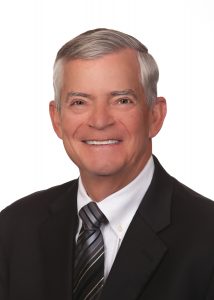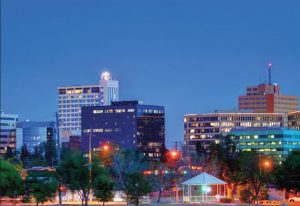As ESG (environmental, social and governance) and energy-transition-related concerns have caused most large and midsize banks to exit the oil and gas industry, local lenders like Midland’s Community National Bank and Odessa-based Southwest Bank have benefited by seeing some of those customers come their way. On the borrower side, Northern Oil and Gas has funded its Permian Basin expansion through a variety of sources, including a syndicate of 14 lenders overseen by Wells Fargo.
Toby Payne, senior vice president of lending for Community National Bank, and George Friesen, a consulting petroleum engineer for the bank, laid out their scenario.
Said Payne, “I think it’s been real positive for us. We’re an independent bank, and we’ve been able to look at some deals that we historically have not had a chance to look at.” Midsize and larger borrowers, who previously would have banked in Houston, Dallas, or elsewhere, have been turned away by the larger institutions due to the aforementioned ESG issues.
There is also “Wall Street pressure from the public banks,” making them fossil-fuel-lending averse. Oil price crashes due to COVID shutdowns in 2020 and 2021 precipitated significant financial losses as well, pushing other banks out of the industry,” Payne said. But, “We’ve just had lots of opportunities—it’s been great.”
Also, producers who previously sought institutions associated with ESG-conscious equity lenders are bringing CNB new opportunities.
As for ESG concerns on the part of borrowers, Friesen noted that many of their deals go to companies needing capital for non-operated assets. In that case the borrower has no concerns because that is solely the operator’s issue. But even on operated deals only a few clients are expressing ESG interests.
Both foresee a day when bank regulations may require ESG issues to be addressed, but Payne said the bigger banks usually face those regulatory issues first. As “about a $2 billion bank,” in Payne’s words, CNB could find it may be a while before regulations reach down that far.
Another driver to independent bank lending is an increase in divestments due to higher energy prices, Friesen added. “That opens up quite a lot of opportunities for medium-to-smaller companies to jump in there and buy those assets here in the Permian.”
Without quoting specific numbers, Payne said he feels the size of the average deal in recent months is much larger than in previous years. In addition to larger loans, the number of transactions is up in spite of higher interest rates, Payne noted. “I would say our demand, this year, over last year, is up significantly, despite the [interest rate] increase.”
Greater operating efficiencies with automation and other new technologies have helped the financing business by lowering the break-even price for oil, Payne said, acknowledging something the bank factors in when considering a transaction. And while WTI prices ended 2022 lower than they had been for much of the year, many experts predict a China exit from COVID restrictions could greatly boost demand. That would push oil prices back up to around $100 per barrel by midyear 2023.
Most of CNB’s loans go to E&Ps, but both said they make significant loans to service companies as well. “For George and me, our focus is on reserve-based lending, but as a whole, our bank does a lot of service company lending,” said Payne.
Southwest Bank
Southwest Bank’s Senior Vice President and Manager of the Oil and Gas Lending Group, Wes Webb, says the bank opened that group in May of 2022, with Webb at the helm. Webb’s 25 years of oil and gas lending experience combined with the seven years’ experience of the group’s other member, Davis Browning, means that even though the department is new, its lenders are seasoned veterans.
For decades the bank had provided capital to service companies, but had never done production-based lending. The timing was good for them because, as stated above, most other banks were leaving the oil and gas market so, “There was less competition because there are fewer banks that are actually in this market,” he said.
Big banks’ shift away from oil and gas lending does not just mean they aren’t making new loans. “A lot of the banks that have decided to exit this market, they need [existing] clients to find a new home.” Because those banks are dismissing existing oil and gas clients, “We and other banks are reaping the benefit of that,” Webb said.
The bank’s focus is on small independent producers. “Right now, you’re seeing borrowers borrow money to develop [drilling], and even some acquisitions.” The number of acquisitions is somewhat higher than usual, Webb said, due to the current high oil prices. Typically firms only buy properties when commodity prices are low, under the “buy low, sell high” investor mantra. “But,” he explained, “one of the things we’re seeing now is, because of the recent downturn, you’re seeing more people exit out of the market.”
Still, he noted, development and drilling account for the great majority of loans.
And while the market as a whole may see a great amount of volatility, Webb observed that oil and gas lending is usually strong no matter the commodity price status. “When they’re up, they [operators] are wanting to develop, and when prices are down they’re looking to acquire [new acreage],” he said, adding, “Companies always need funds.”
When prices are low for an extended time, as they were in 2020 and 2021, Webb sees relationship banking as important in preventing loan defaults. “I want to [loan to] people that I know, that I can ride those waves with; that we have a good enough relationship with that the bank can work with them, but I know that they’re going to stand behind their word and behind the [loan] documents. We’re going to work together to make it work until times get better, which they always do.”
Working with small independents, Webb sees little change in where or how those companies are working, even as world events change. Independents, by nature, concentrate on smaller areas where they have familiarity, rarely making significant shifts in location or operations. “Above all, independents crave stability,” he said. “They can make money at $50 a barrel. They can also make money at $150 a barrel. What makes their lives difficult is the fluctuation, and the rapid fluctuation.”
And while hedging can mitigate those changes, even that option is getting harder to find. During the last downturn, hedge providers began reducing their exposure to small independent oil and gas companies.
NOG Spreads Its Funding
Northern Oil and Gas has been one of the companies using financing for acquisitions, on a large scale. Over the last five years, through a series of transactions, they have become a significant player in the Permian Basin.
Already ranking as the largest public non-operator while doing business solely in the Williston Basin of North Dakota under previous management (involved in almost half of all wells ever drilled there), current CEO Nick O’Grady and a new management team took the reins in 2018. Acquiring at that point two of their largest Williston competitors, they realized, “If we wanted to continue to grow the business, we were going to have to look externally, especially [under] the law of large numbers.”
The obvious answer to the focus change is still apparent, he said, noting that there are seven times the number of drilling rigs operating in the Permian as there are in the Williston.
O’Grady had observed many operators paying large amounts to hold acreage for the future instead of developing it right away. “As a non-operator, the pace of development is really critical to your IRR [internal rate of return]. So you might buy great rock, but if the operator doesn’t come back for five years you can incinerate capital.” They began looking then, but did not secure an agreement due to widely varying assessments between Northern and the counterparties they approached.
The shutdowns of 2020 changed the landscape, however. Entry costs became more economically focused then, and Northern’s Permian acquisitions began late in that year.
Deciding on Money Options
In 2021 the company made four major acquisitions, two in the Permian, issuing equity for three of them. And in October of 2022 they issued a bond for $500 million, announcing two transactions after that. Northern has a reserves based lending facility with what he called “Very reasonable money” due in 2027. The facility is based on the value of the company’s reserves and “very conservatively underwritten; we have a 14-bank syndicate” providing the money. In 2021 they issues bonds due in 2028 and a new issue this year due in 2029, the former of which they issued in two tranches.
“Public currency is part of our lifeblood,” O’Grady said, adding that just being a publicly traded company does not assure access to capital. “You really need to earn it, and build a shareholder base that understands that you’re doing value-added transactions.” In the case of the $500 million bond, he noted that investors oversubscribed it by several times within two hours of its announcement, so the trust is indeed there for Northern’s investors.
This is a major reversal from the pre-2018 days, O’Grady said, when about “75 percent of shareholders were distressed debt holders. Now the company has outperformed the stock index four of the last five years, the pandemic being the exception. O’Grady said that, at $3 billion market capitalization and a $5 billion enterprise total, that is about five times larger than Northern was in 2018. Their current dividend rate is just under four percent.
O’Grady said their investment strategy uses modern portfolio theory, which involves spreading investments to reduce volatility. “We are in three basins, we have over 100 active operators, and we’re in over 9,000 active wells today,” he said.
The geographic spread helps protect them from volatility. They’re also protected because the company’s engineering staff vets every investment for its economic viability at a variety of oil prices. And, “We are prolific hedgers, so when we purchase things we tend to hedge things along the way. We believe that that helps mitigate some of that underwriting risk. And as an active acquirer, the timing of that can have a huge impact.” Prolifically buying at discounted prices in 2021, then seeing oil and gas values spike in early 2022, was very fortuitous.
In purchases, they’ve looked for non-operated interest in areas they thought would be developed “in a relatively ratable fashion.” Now, however, they’re more looking for companies seeking a partner to help fund growth. They are discussing co-purchasing or co-developing lands, “and I think for operators in the Permian who sometimes have more development opportunities than they have capital, as a public company we can be a very good partner, distinct from the usual financial sources you would use.”
In the latter scenario, Northern seeks to use its capital and potentially new capital from its investors, then redeploy that money to research and invest in development alongside operators to expand production.
In spite of external forces such as ESG and energy transition concerns, the oil industry in the Permian and elsewhere is finding new investment resources to continue doing what the Permian has done for over 100 years—to help power the nation.
Paul Wiseman is a freelance writer in the energy sector. His email address is fittoprint414@gmail.com.














